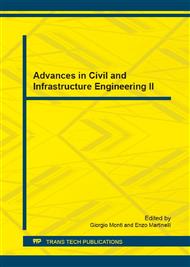p.233
p.240
p.248
p.257
p.266
p.273
p.281
p.290
p.299
Estimation of Floor Response Spectra Using the Uncoupled Modal Response History Analysis
Abstract:
In performance-based earthquake engineering, probabilistic seismic demand models are usually developed by using methods which need a large number of nonlinear dynamic analyses to be run. In order to reduce the numerical effort, simplified methodologies of analysis have been proposed. Objective of the present study is to use the uncoupled modal response history analysis for the estimation of acceleration floor spectra, engineering demand parameters commonly used for measuring seismic demand in acceleration-sensitive non-structural elements. The procedure is evaluated for a 6-story reinforced concrete frame case study, designed to be representative of an existing structure lacking in specific capacity design rules.
Info:
Periodical:
Pages:
266-272
Citation:
Online since:
July 2016
Authors:
Keywords:
Price:
Сopyright:
© 2016 Trans Tech Publications Ltd. All Rights Reserved
Share:
Citation:


